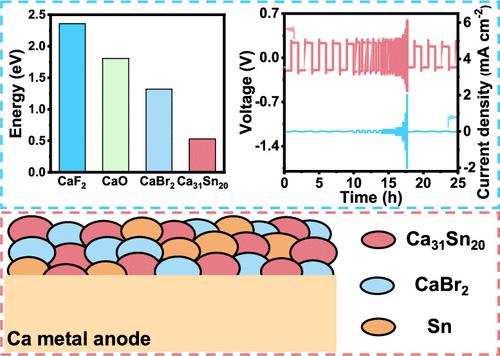当前位置:
X-MOL 学术
›
ACS Energy Lett.
›
论文详情
Our official English website, www.x-mol.net, welcomes your
feedback! (Note: you will need to create a separate account there.)
Realizing Wide-Temperature Reversible Ca Metal Anodes through a Ca2+-Conducting Artificial Layer
ACS Energy Letters ( IF 19.3 ) Pub Date : 2022-11-30 , DOI: 10.1021/acsenergylett.2c02366 Zhen Hou 1 , Rui Zhou 1 , Zhiwen Min 2 , Ziheng Lu 3 , Biao Zhang 1
ACS Energy Letters ( IF 19.3 ) Pub Date : 2022-11-30 , DOI: 10.1021/acsenergylett.2c02366 Zhen Hou 1 , Rui Zhou 1 , Zhiwen Min 2 , Ziheng Lu 3 , Biao Zhang 1
Affiliation

|
Room-temperature Ca deposition/stripping is impeded by the formation of ionic insulating interfaces. Electrolyte optimization could partially enhance Ca reversibility by tailoring the interfaces, but the precise regulation of the composition remains challenging. Herein, we construct an ex situ artificial layer on Ca metal via a facile displacement reaction between metal halides and Ca. These Ca-driven spontaneous layers with precisely controlled interfacial chemistry consist of a Ca metal alloy phase and a calcium halide matrix for conducting Ca2+ and insulating the electrons, as revealed by theoretical and experimental investigations. In particular, the Ca31Sn20/CaBr2 interface enables Ca metal anodes to achieve low polarization and humid air stability over a wide temperature range from −25 to +50 °C. This proof-of-concept work provides an alternative approach to boost Ca2+ diffusivity through customized interfacial chemistry regulation.
中文翻译:

通过 Ca2+ 导电人工层实现宽温可逆 Ca 金属阳极
离子绝缘界面的形成阻碍了室温 Ca 沉积/剥离。电解质优化可以通过调整界面来部分增强 Ca 的可逆性,但组成的精确调节仍然具有挑战性。在此,我们通过金属卤化物和 Ca 之间的轻松置换反应在 Ca 金属上构建了一个非原位人工层。正如理论和实验研究所揭示的那样,这些 Ca 驱动的自发层具有精确控制的界面化学,由 Ca 金属合金相和用于传导 Ca 2+和绝缘电子的卤化钙基质组成。特别地,Ca 31 Sn 20 /CaBr 2界面使 Ca 金属阳极能够在 −25 至 +50 °C 的宽温度范围内实现低极化和潮湿空气稳定性。这项概念验证工作提供了一种替代方法,可通过定制的界面化学调节来提高 Ca 2+扩散率。
更新日期:2022-11-30
中文翻译:

通过 Ca2+ 导电人工层实现宽温可逆 Ca 金属阳极
离子绝缘界面的形成阻碍了室温 Ca 沉积/剥离。电解质优化可以通过调整界面来部分增强 Ca 的可逆性,但组成的精确调节仍然具有挑战性。在此,我们通过金属卤化物和 Ca 之间的轻松置换反应在 Ca 金属上构建了一个非原位人工层。正如理论和实验研究所揭示的那样,这些 Ca 驱动的自发层具有精确控制的界面化学,由 Ca 金属合金相和用于传导 Ca 2+和绝缘电子的卤化钙基质组成。特别地,Ca 31 Sn 20 /CaBr 2界面使 Ca 金属阳极能够在 −25 至 +50 °C 的宽温度范围内实现低极化和潮湿空气稳定性。这项概念验证工作提供了一种替代方法,可通过定制的界面化学调节来提高 Ca 2+扩散率。










































 京公网安备 11010802027423号
京公网安备 11010802027423号